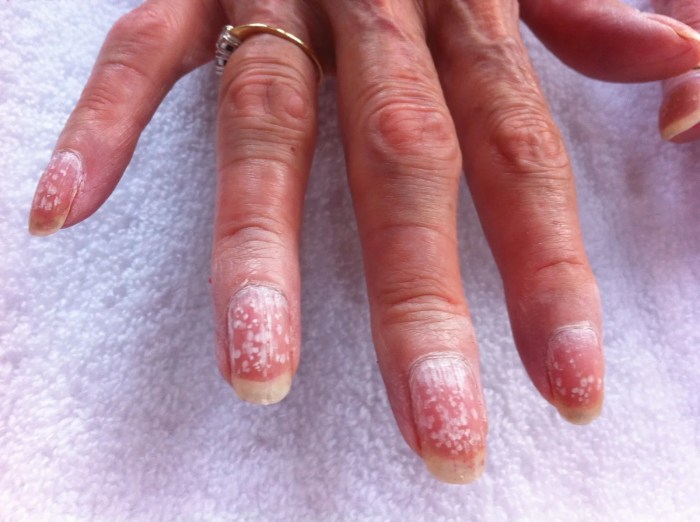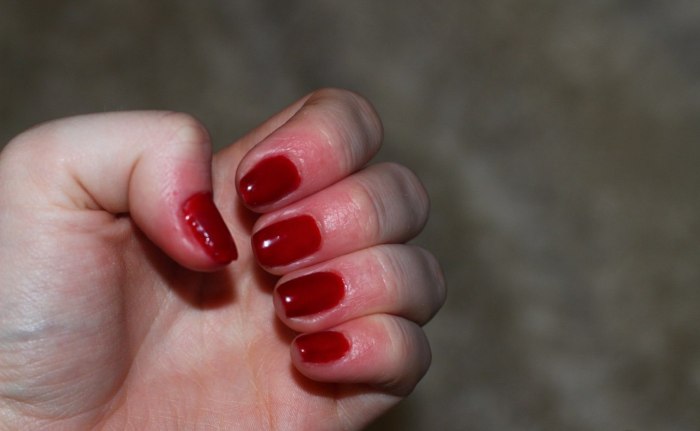Allergic to Nail Polish A Comprehensive Guide
Understanding Allergic Reactions to Nail Polish

Source: techinfus.com
Allergic to nail polish – Nail polish allergies, while not uncommon, can significantly impact an individual’s daily life and self-expression. Understanding the causes, symptoms, and management of these allergies is crucial for effective treatment and prevention. This section will delve into the various aspects of allergic reactions to nail polish, providing a comprehensive overview of the condition.
Types of Allergic Reactions
Allergic reactions to nail polish can manifest in several ways, ranging from mild irritation to severe contact dermatitis. These reactions are primarily caused by contact with certain chemicals in the polish, triggering an immune response in sensitive individuals. The severity of the reaction depends on the individual’s sensitivity, the concentration of the allergen, and the duration of exposure.
Common Allergenic Ingredients
Many components in nail polish have the potential to trigger allergic reactions. Formaldehyde, toluene, dibutyl phthalate (DBP), camphor, and resin are among the most frequent culprits. Formaldehyde, a preservative, is a known irritant and sensitizer. Toluene, a solvent, can cause skin irritation and dryness. DBP, a plasticizer, is linked to hormonal disruption and skin problems.
Camphor, often used for its fragrance, can cause irritation and allergic contact dermatitis. Resins, used to create the polish film, can also be problematic for sensitive individuals. The specific ingredient causing the reaction can vary greatly from person to person.
Symptoms of Nail Polish Allergies
Symptoms of nail polish allergies can vary widely in severity and presentation. Mild reactions may include redness, itching, and slight swelling around the nail bed. More severe reactions can manifest as blistering, intense itching, skin cracking, and even weeping sores. In some cases, individuals may experience symptoms beyond the nail area, such as swelling of the eyelids or face if they touch their face after applying polish.
Nail discoloration or changes in nail texture can also occur.
Identifying a Specific Allergen
Pinpointing the exact allergen in nail polish can be challenging. A detailed history of the onset of symptoms and the types of nail polish used is essential. Patch testing, conducted by a dermatologist, is the most reliable method for identifying specific allergens. This involves applying small amounts of suspected allergens to the skin and monitoring the reaction over several days.
Comparison of Mild and Severe Allergic Reactions
| Symptom | Mild Reaction | Severe Reaction |
|---|---|---|
| Itching | Mild itching around the nail | Intense, widespread itching, possibly spreading beyond the nail area |
| Redness | Slight redness around the nail | Significant redness, swelling, and inflammation |
| Blistering | Absent | Presence of blisters, possibly weeping sores |
| Other Symptoms | Minor dryness or cracking | Significant skin cracking, swelling of the eyelids or face |
Diagnosis and Testing
Accurate diagnosis of nail polish allergies relies on a combination of patient history and specific diagnostic tests. Dermatologists utilize various methods to identify the causative allergen and determine the appropriate treatment plan.
Methods of Diagnosis
Dermatologists typically begin by taking a thorough patient history, including details about the onset of symptoms, types of nail polish used, and any other relevant medical information. A physical examination of the affected nails and surrounding skin is also conducted. Patch testing is the primary diagnostic tool used to identify specific allergens. This involves applying small amounts of suspected allergens to the skin and monitoring the reaction over several days.
Patch Testing Procedures
Patch testing is performed by applying small amounts of suspected allergens to the back or arms. These are usually held in place with hypoallergenic tape for 48 hours. The skin is then observed for a reaction, and a follow-up assessment is done 72 hours after the patch is removed. A positive reaction indicates an allergy to that specific ingredient.
Self-Patch Test (Disclaimer: Consult a dermatologist before attempting a self-patch test. Improper technique can lead to inaccurate results and potential complications.)
- Choose a small, inconspicuous area of skin (e.g., inner forearm).
- Apply a tiny amount of a suspected allergen (e.g., a specific nail polish ingredient) to the skin.
- Cover the area with hypoallergenic tape.
- Observe the area for 48-72 hours for any reaction (redness, itching, swelling).
- Remove the tape and monitor the area for a few more days.
Diagnostic Flowchart
The diagnostic process typically follows a structured approach:
(Illustrative flowchart would be displayed here. The flowchart would visually depict the steps involved in diagnosing nail polish allergies, starting with patient history, physical examination, and progressing to patch testing and confirmation of the diagnosis.)
Management and Treatment
Effective management of nail polish allergies involves a combination of treatment options and lifestyle modifications. The goal is to alleviate symptoms, prevent future reactions, and maintain healthy nails.
Treatment Options
Treatment for nail polish allergies primarily focuses on managing symptoms and preventing further exposure to the offending allergen. Topical corticosteroids, such as hydrocortisone cream, can reduce inflammation and itching. Oral antihistamines can help alleviate itching and other allergic symptoms. In severe cases, a dermatologist might prescribe stronger topical steroids or other medications.
Topical Corticosteroids and Antihistamines
Topical corticosteroids are applied directly to the affected area to reduce inflammation. Oral antihistamines are taken orally to help relieve itching and other allergic symptoms. The choice of medication and dosage depends on the severity of the reaction and individual needs. Always follow the instructions provided by your doctor or pharmacist.
Symptom Management and Prevention
Avoiding nail polish containing the identified allergen is the most important preventative measure. Choosing hypoallergenic nail polishes or alternatives is crucial. Proper nail hygiene, including gentle nail cleaning and avoiding harsh chemicals, can also help prevent irritation.
Alternative Nail Products
Several alternative nail products are available for individuals with allergies. These include hypoallergenic nail polishes formulated without common allergens, breathable nail wraps, and natural nail strengtheners. Always check the ingredient list to ensure the product is free of known allergens.
Lifestyle Changes
- Avoid nail polish containing known allergens.
- Use hypoallergenic nail polishes or alternatives.
- Practice good nail hygiene.
- Keep nails short and clean.
- Wear gloves when handling harsh chemicals.
- Moisturize the skin around the nails regularly.
Nail Polish Ingredients and Their Potential Allergens
Understanding the potential allergens in nail polish formulations is vital for preventing and managing allergic reactions. This section details common ingredients and their associated risks.
Common Allergens in Nail Polish
Formaldehyde, toluene, DBP, camphor, and various resins are among the most common allergens found in nail polish. These ingredients can cause a range of reactions, from mild irritation to severe contact dermatitis. The allergenic potential of these ingredients can vary depending on the concentration and the individual’s sensitivity.
Allergenic Potential of Different Nail Polish Types
Gel nail polishes, due to their curing process involving UV light and often higher concentrations of certain chemicals, may carry a higher risk of allergic reactions compared to traditional nail polishes. However, the specific allergenic potential depends on the exact ingredients used in each formulation.
Role of Preservatives and Additives
Preservatives and other additives, while often necessary for product stability and longevity, can contribute to allergic reactions. These ingredients can act as irritants or sensitizers, triggering an immune response in susceptible individuals. Choosing products with minimal additives can reduce the risk of allergic reactions.
Common Nail Polish Ingredients and Associated Risks
| Ingredient | Potential Allergic Reaction | Risk Level (Low, Medium, High) | Notes |
|---|---|---|---|
| Formaldehyde | Contact dermatitis, irritation | High | A known sensitizer and irritant. |
| Toluene | Irritation, dryness | Medium | A solvent that can dry out the skin. |
| Dibutyl Phthalate (DBP) | Skin irritation, hormonal disruption | Medium | A plasticizer with potential health concerns. |
| Camphor | Irritation, allergic contact dermatitis | Medium | Often used for fragrance. |
| Resins | Contact dermatitis | Medium | Various types with varying allergenic potential. |
Prevention and Safe Practices: Allergic To Nail Polish
Preventing nail polish allergies involves careful selection of products, proper application techniques, and maintaining good nail hygiene. This section provides guidance on safe practices to minimize the risk of allergic reactions.
Choosing Hypoallergenic Nail Polishes, Allergic to nail polish
Opting for nail polishes labeled as “hypoallergenic” or “3-free” (free of formaldehyde, toluene, and DBP) can significantly reduce the risk of allergic reactions. Always carefully examine the ingredient list to ensure the product is free of known allergens.
Importance of Proper Ventilation
Adequate ventilation is essential when applying nail polish, especially those containing volatile organic compounds. Opening windows or using a fan can help disperse fumes and reduce exposure to potentially irritating chemicals.
Safe Nail Polish Removal
Gentle nail polish removal is crucial to minimize irritation. Use an acetone-free remover to reduce dryness and irritation. Avoid harsh scrubbing or prolonged soaking of the nails. Apply remover gently and wipe off polish with a soft cotton pad.
Preparing Nails Before Application
Before applying nail polish, ensure nails are clean, dry, and free of any oil or lotion. This helps the polish adhere better and reduces the chance of trapping irritants against the nail bed. Lightly buffing the nail surface can also improve adhesion.
Healthy vs. Allergic Nail Appearance

Source: techinfus.com
A healthy nail is typically smooth, even in color, and free of any discoloration or unusual texture. An allergic reaction can manifest as redness, swelling, itching, blistering, cracking, or discoloration of the nail and surrounding skin. The nail may also become thickened or brittle.
Helpful Answers
Can I be allergic to only certain nail polish brands?
Yes, allergic reactions can be specific to certain brands or formulations due to varying ingredients and concentrations.
How long does it take for a nail polish allergy to develop?
It can vary, but it often takes repeated exposure over time before a reaction manifests.
Are there any home remedies for mild nail polish allergy symptoms?
Mild symptoms might respond to cool compresses and over-the-counter hydrocortisone cream. However, consult a doctor for persistent or worsening symptoms.
Can I still use nail polish remover if I have a nail polish allergy?
Use acetone-free removers as acetone can be irritating. Always test a small area first.
















